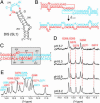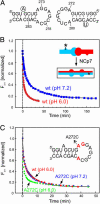A proton-coupled dynamic conformational switch in the HIV-1 dimerization initiation site kissing complex
- PMID: 14734802
- PMCID: PMC337028
- DOI: 10.1073/pnas.0307966100
A proton-coupled dynamic conformational switch in the HIV-1 dimerization initiation site kissing complex
Abstract
In HIV type 1 (HIV-1), the dimerization initiation site (DIS) is the sequence primarily responsible for initiating the noncovalent linkage of two homologous strands of genomic RNA during viral assembly. The DIS loop contains an autocomplementary hexanucleotide sequence and forms a symmetric homodimer through a loop-loop kissing interaction. In a structural rearrangement catalyzed by the HIV-1 nucleocapsid protein (NCp7) and suggested to be associated with maturation of the budded viral particle, the DIS converts from a metastable kissing dimer to an extended duplex. Here, we demonstrate that the DIS kissing dimer displays localized conformational dynamics that result from the specific protonation of the N1 base nitrogen of the DIS loop residue A272 at near-physiological pH. The rate of NCp7-catalyzed maturation of the DIS kissing dimer is also shown to directly correlate with the observed proton-coupled conformational dynamics, where NCp7 is found to convert the dynamic A272 protonated state with a faster rate. Taken together, these results reveal a previously undescribed role for base protonation in modulating local RNA structure and demonstrate a mechanism for promoting the chaperone-mediated structural rearrangement of a kinetically trapped RNA conformational state.
Figures





Similar articles
-
Mechanism of nucleocapsid protein catalyzed structural isomerization of the dimerization initiation site of HIV-1.Biochemistry. 2002 Dec 17;41(50):14762-70. doi: 10.1021/bi0267240. Biochemistry. 2002. PMID: 12475224
-
Structure and dimerization of HIV-1 kissing loop aptamers.J Mol Biol. 2001 Aug 17;311(3):475-90. doi: 10.1006/jmbi.2001.4879. J Mol Biol. 2001. PMID: 11493002
-
Non-canonical interactions in a kissing loop complex: the dimerization initiation site of HIV-1 genomic RNA.J Mol Biol. 1997 Jul 4;270(1):36-49. doi: 10.1006/jmbi.1997.1096. J Mol Biol. 1997. PMID: 9231899
-
A structure-based approach for targeting the HIV-1 genomic RNA dimerization initiation site.Biochimie. 2007 Oct;89(10):1195-203. doi: 10.1016/j.biochi.2007.03.003. Epub 2007 Mar 12. Biochimie. 2007. PMID: 17434658 Review.
-
Dimerization of retroviral genomic RNAs: structural and functional implications.Biochimie. 1996;78(7):639-53. doi: 10.1016/s0300-9084(96)80010-1. Biochimie. 1996. PMID: 8955907 Review.
Cited by
-
Stabilities of HIV-1 DIS type RNA loop-loop interactions in vitro and in vivo.Nucleic Acids Res. 2006 Jan 12;34(1):334-42. doi: 10.1093/nar/gkj435. Print 2006. Nucleic Acids Res. 2006. PMID: 16410613 Free PMC article.
-
Retroviral RNA Dimerization: From Structure to Functions.Front Microbiol. 2018 Mar 22;9:527. doi: 10.3389/fmicb.2018.00527. eCollection 2018. Front Microbiol. 2018. PMID: 29623074 Free PMC article. Review.
-
New Structure Sheds Light on Selective HIV-1 Genomic RNA Packaging.Viruses. 2015 Aug 24;7(8):4826-35. doi: 10.3390/v7082846. Viruses. 2015. PMID: 26305251 Free PMC article.
-
Understanding the isomerization of the HIV-1 dimerization initiation domain by the nucleocapsid protein.J Mol Biol. 2007 Jun 8;369(3):812-28. doi: 10.1016/j.jmb.2007.03.065. Epub 2007 Mar 30. J Mol Biol. 2007. PMID: 17466332 Free PMC article.
-
Impaired RNA incorporation and dimerization in live attenuated leader-variants of SIVmac239.Retrovirology. 2006 Dec 21;3:96. doi: 10.1186/1742-4690-3-96. Retrovirology. 2006. PMID: 17184529 Free PMC article.
References
Publication types
MeSH terms
Substances
Grants and funding
LinkOut - more resources
Full Text Sources

